Lancaster, Lancashire
Up to 1834
A parliamentary report of 1777 recorded a workhouse in operation in Lancaster Borough with accommodation for up to 80 inmates. The town built a workhouse on the south side of Quernmore Road in 1788.
Eden, in his 1797 survey of the poor in England, reported of Lancaster that:
After 1834
The Lancaster Poor Law Union was formed on 10th December 1839. Its operation was overseen by an elected Board of Guardians, 26 in number, representing its 19 constituent parishes as listed below (figures in brackets indicate numbers of Guardians if more than one):
County of Lancaster:
Aldcliffe, Ashton with Stodday, Bulk, Carnforth, Cockerham, North and South Ellel (2), Heaton with Oxcliffe, Lancaster (6), Middleton, Overton, Overton Wyersdale, Priest Hutton, Scotforth, Silverdale, Skerton (2), Thurnham, Warton with Lindeth, Yealand Conyers, Yealand Redmayne.
Later Additions: Bolton le Sands (from 1869), Cockersand Abbey (from 1858), Heysham (from 1869), Morecambe (1924-28), Poulton Barre and Torrisholme (1869-1924), Slyne with Hest (from 1869).
The population falling within the Union at the 1831 census had been 25,006 with parishes ranging in size from Aldcliffe (population 96) to Lancaster itself (12,613).
The Lancaster Union took over the existing workhouse on Quernmore Road. The building was greatly enlarged in 1840-41 at a cost of £4,000. The layout of the new main building did not follow any of the standard designs but contained elements of both the 200-pauper and courtyard plans.
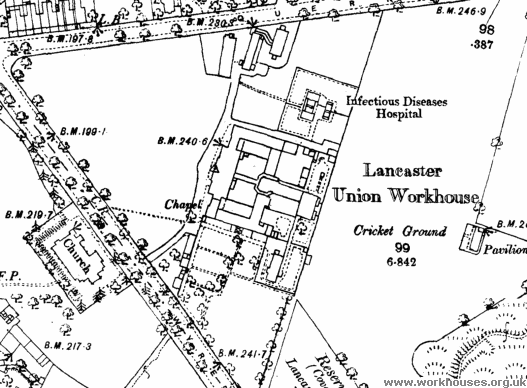
Lancaster workhouse site, 1891
A cluster of buildings were later added at the north of the workhouse site. These included the new porter's lodge and receiving wards in 1889. Other buildings included an infectious hospital and children's home at the north-east, and an infirmary to the south. The enlarged layout is shown on the 1911 map below.
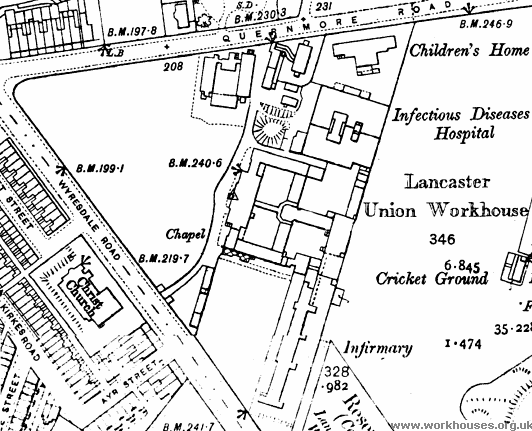
Lancaster workhouse site, 1911
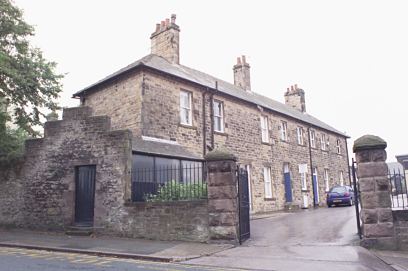
Lancaster entrance from the north, 2001.
© Peter Higginbotham.
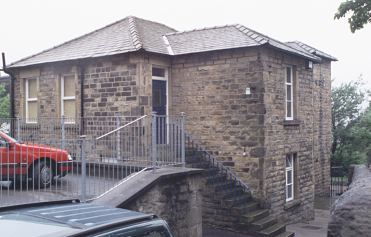
Lancaster entrance from the north-east, 2001.
© Peter Higginbotham.
The children's home could accommodate up to 60 boys and girls.
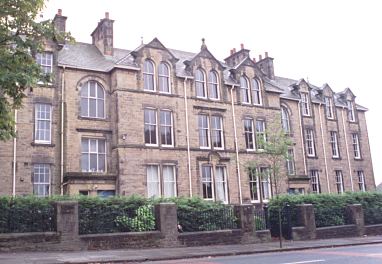
Lancaster workhouse former children's home from the north, 2001.
© Peter Higginbotham.
A single storey block to the west of the children's home is said to have been a vagrants' ward.
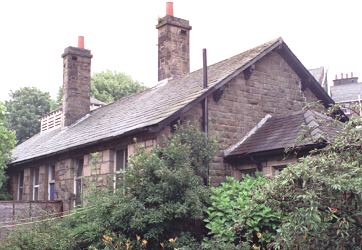
Lancaster vagrants' block from the south-east, 2001.
© Peter Higginbotham.
After 1930, the workhouse became Parkside Institution under the control of Lancashire County Council Public Assistance Committee. In 1948 it joined the new National Health Service as Bay View Hospital and continued in operation until 1962.
The main workhouse building no longer exists. The surviving blocks at the north of the site now form part of the Lancaster Royal Grammar School premises.
Staff
Inmates
Records
Note: many repositories impose a closure period of up to 100 years for records identifying individuals. Before travelling a long distance, always check that the records you want to consult will be available.
- Lancashire Record Office, Bow Lane, Preston, Lancashire, PR1 2RE. Holdings include: Guardians' minutes (1839-1930); Relief books (1894-1945); Pauper lunatic records (1865-1923); Creed registers (1926-46); etc.
Bibliography
- T. Bulmer & Co. (1912) History, Topography, and Directory of Lancaster & District.
Links
- None.
Unless otherwise indicated, this page () is copyright Peter Higginbotham. Contents may not be reproduced without permission.


